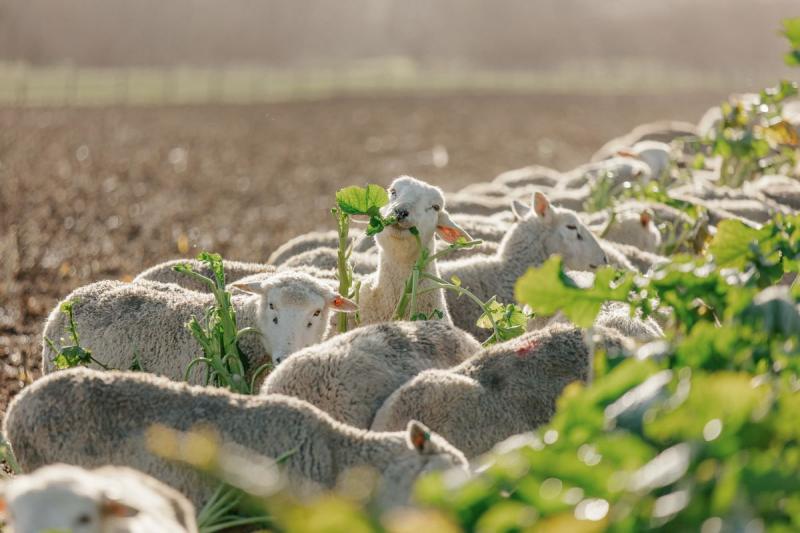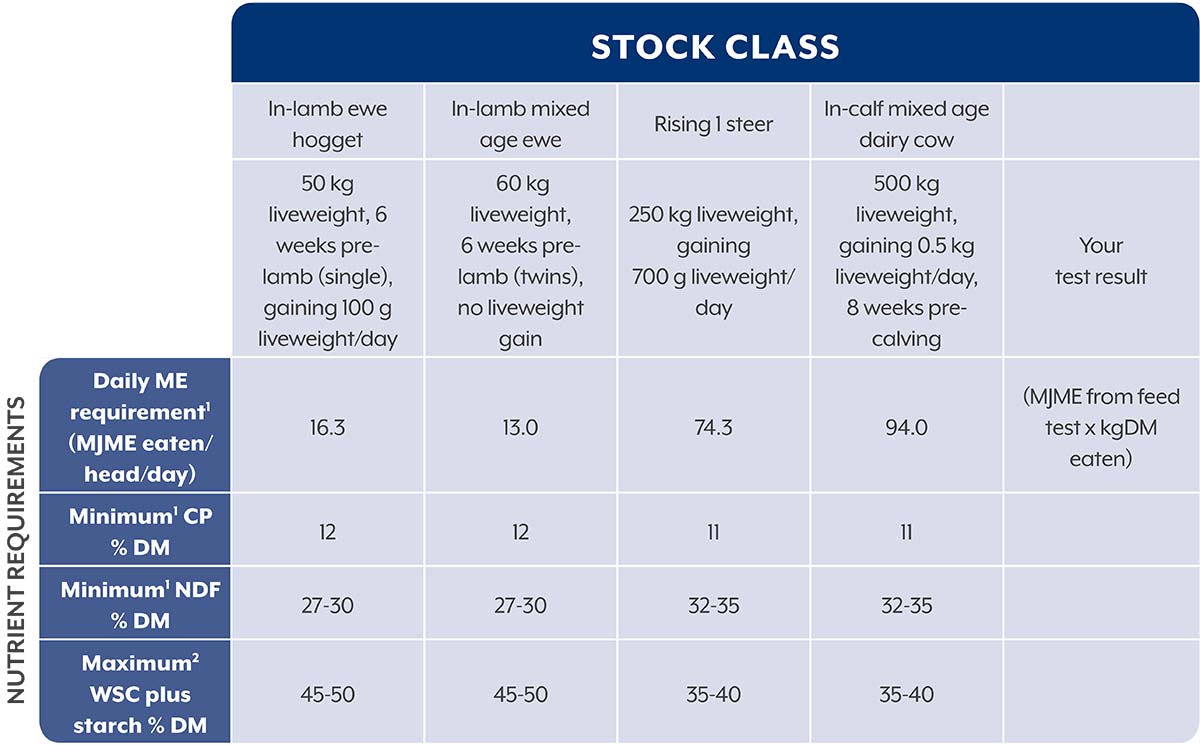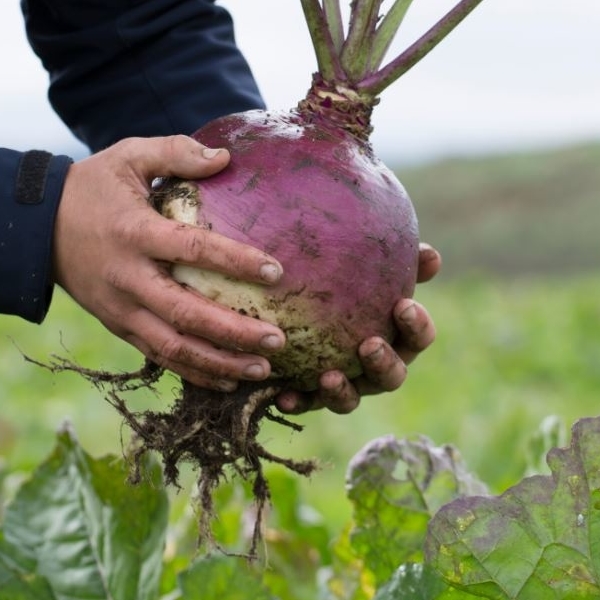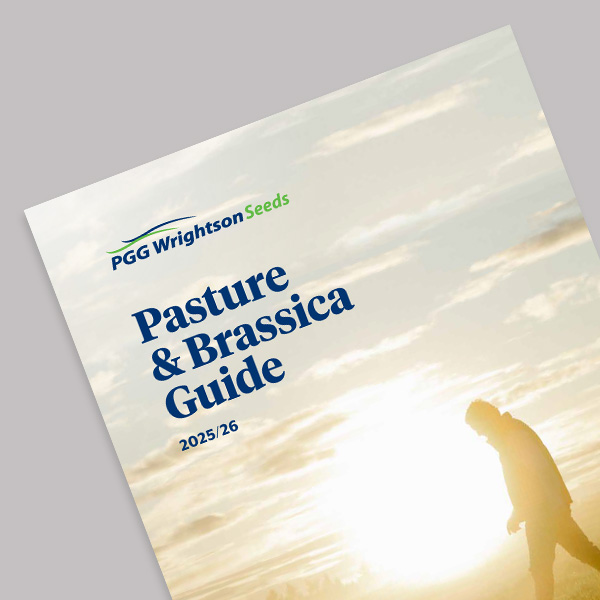Brassica feed quality
Knowing the feed quality of the brassica crops and supplements you plan to feed to animals helps determine if the planned diet will meet the nutritional requirements of your animals.
FEED QUALITY AND TESTING
New Zealand feed testing laboratories have a wide array of tests available to describe the quality of our feeds. Brassicas are routinely tested by laboratories. Feed test results vary depending on:
Brassica species.
- Bulb crops (e.g. swedes, turnips) usually have the highest megajoules of metabolisable energy (MJME) and water soluble carbohydrate (WSC; sugar) content
Ratio of leafy tops to bulbs for swedes and turnips.
- Bulbs contain less protein than tops; variable top to bulb ratios change the delivery of nutrients to animals. Therefore when assessing the dry matter (DM) yield for bulb crops, it is important to measure the leafy tops and bulb yields separately
Brassica cultivar.
- Feed quality of kale cultivars can vary greatly. Giant type kales contain less MJME and more neutral detergent fibre (NDF) than Kestrel marrowstem kale
Sowing date relative to plant maturity.
- Plant quality may change as plants near maturity. Pre-reproductive and reproductive plants are of poorer feed quality than rapidly-growing, vegetative (leafy) plants. Reproductive plants may also contain compounds that can make animals unwell
Fertiliser use.
- The type of fertiliser, amount used and timing of application (i.e. at sowing or later) will have an effect on the feed quality of brassicas. Nitrogen (N) fertiliser application increases levels of crude protein (CP) in brassicas. If plant available N is limiting, crop yields may be compromised and CP levels in brassicas may be too low to meet the nutritional requirements of young, growing and/or heavily pregnant animals
These notes are provided as a guide only. For more specific crop review and recommendations relevant to your crop, contact your PGG Wrightson Seeds Sales Agronomist. For more animal health advice, contact your veterinarian.

Feed test results at a galnce
| DM% | Dry matter percentage; the amount of dry matter in the brassica plant expressed as a percentage of wet weight. |
| MJME | Megajoules of metabolisable energy, expressed as a percentage of dry matter, is calculated from the digestibility of the brassica. |
| CP | Crude protein, expressed as a percentage of dry matter. CP is calculated by multiplying the N content of brassicas x 6.25. |
| WSC | Water soluble carbohydrates (sugars), expressed as a percentage of dry matter. |
| NDF | Neutral detergent fibre, expressed as a percentage of dry matter. NDF is a measure of the cellulose, hemicellulose and lignin in brassica plants. |
| ADF | Acid detergent fibre, expressed as a percentage of dry matter is, like NDF, a measure of the fibre content of brassicas and includes just cellulose and lignin. |
NUTRIENT REQUIREMENTS OF VARIOUS STOCK CLASSES GRAZING A BRASSICA CROP ON FLAT GROUND
Fill in your brassica crop feed test result plus supplements to compare with livestock requirements.

1Minimum amounts suggested for optimum animal productivity.
2 Maximum amounts suggested to support optimum animal productivity (once adjusted to the crop; actual target level varies depending on level of fibre in diet).
INTERPRETATION OF COMMON FORAGE BRASSICA FEED QUALITY TESTS
METABOLISABLE ENERGY (MJME)
Metabolisable energy (MJME) is the energy value of the feed expressed as megajoules (MJ) of metabolisable energy (ME) per kilogram (kg) of dry matter (DM). The energy value of forage brassicas is typically very high. Knowing the MJME value of feed helps to align energy supply from brassica-based diets with energy demand of animals. Both DairyNZ and Beef and Lamb New Zealand have publications on the energy requirements of various stock classes.
CRUDE PROTEIN (CP)
Crude protein (CP) is an estimate of the protein content based on the amount of nitrogen in a feed sample. High performing stock classes will require more protein for milk production or liveweight gain. In most cases, the CP content of forage brassicas meets livestock requirements. Exceptions include when the leafy top is lost from turnips or swedes, leaving only bulb. CP levels in the bulb are low compared to the leaves. Supplementing brassicas with low CP supplements increases the risk of protein deficiency.
NEUTRAL DETERGENT FIBRE (NDF)
Neutral detergent fibre (NDF) is a measure of the structural fibre in the feed. Risk of ruminal acidosis is increased when NDF levels are lower than what an animal requires. Brassicas almost always contain inadequate NDF for cattle and in most cases, insufficient NDF for sheep. Forage brassicas should always be fed with a supplementary feed source of extra NDF (e.g. standing pasture, hay, silage or straw).
WATER SOLUBLE CARBOHYDRATES (WSC)
Water soluble carbohydrates (WSC) are a measure of non-structural carbohydrates that are rapidly and extensively degraded in the rumen. Once the rumen has adjusted to crop over 10-14 days, animals can typically digest the higher levels of WSC found in forage brassicas. Exceptions include the bulbs of swede or turnip crops when few or no leafy tops are present; levels of WSC may exceed 50% of DM.
For more information on the feed quality of different forage brassicas, refer to the following resource: Westwood CT and Mulcock H. (2012). Nutritional evaluation of five species for forage brassica. In Proceedings of the NZ Grasslands Association 74: 31-38.Available online here.


